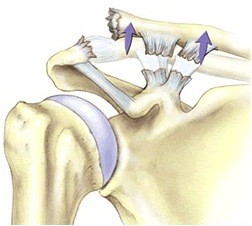What is a ACJ Separation or Disclocation?
The acromioclavicular joint (ACJ) is situated on top of the shoulder joining the clavicle (the collar bone) to the acromion (the tip of the shoulder blade).

There are two ligaments which hold the collar bone in place. The acromioclavicular (AC) ligament attaches the clavicle to the scapula and prevents motion in the horizontal plane. The Coracoclavicular (CC) ligaments go from the coracoid process on the scapula to the clavicle and provide vertical stability.
In a ACJ dislocation, one or both of the above ligaments are torn.

What are the causes?
The injury usually occurs during a fall directly onto the acromion, or the point of the shoulder.
What are the symptoms?
The patient complains of pain and swelling directly over the AC joint and difficulty raising the arm overhead. An obvious deformity might be present caused by the separation of teh acromion and the clavicle. This separation is known as "step-off defomity".
X-rays can assess the degree of separation and rule out an underlying colar bone fracture.
.jpg)
How is it treated?
Non-operative
Most ACJ injuries are treated non-operatively. Ice and anti-inflammatory medications can help reduce pain and inflammation. Short-term immobilisation in a sling can be used for comfort, followed by gentle range-of-motion exercises as pain allows.

Operative
Only injuries with significant separation or displacement of the clavicle from the acromion might require surgery.
Surgery is performed arthroscopically (key hole) and involves reduction of the collarbone to its original position and stabilisation with a device that is passed through the portion of the shoulder blade called the coracoid and through the collarbone. The shoulder is placed in a sling post-operatively to protect the repair, and physical therapy is started to regain motion and strength.
 Loading...
Loading... 


 Arthroscopic
Arthroscopic



